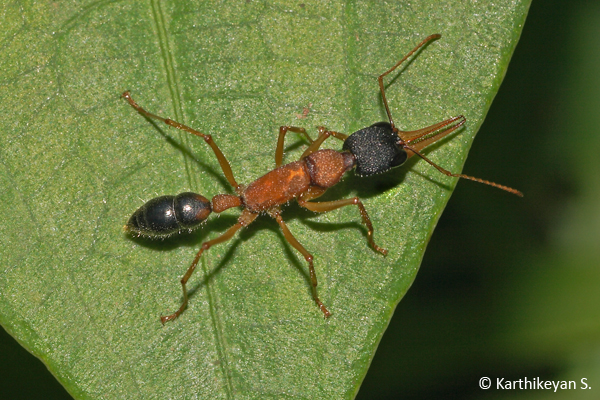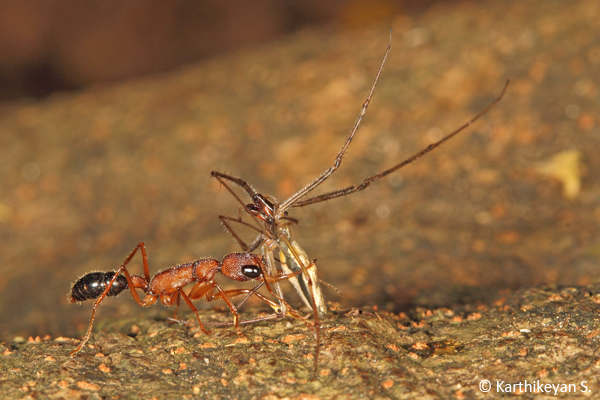It has been over a decade since I was introduced to ants. Over the years, I have seen several ants, not knowing the name of the species and its natural history. Among the multitude of ants, one – the Jumping Ant Harpegnathos saltator – has caught my fancy time and again.
I saw my first Jumping Ant on the outskirts of Bangalore. On that occasion, I observed how it moves about. The ant jumped and lived upto its name!
During one of the forays into the wild back in 2004 near Belgaum, I photographed a jumping ant. At that moment, it was just a Jumping Ant for me. Only later was I told that it was a rare colour morph of the same species – notice the colour of the head (it is black as against the red which is the normal colour)!
As I photographed, oblivious of the rarity of this colour morph, the ant did something very interesting. I was on all my fours and was peering through my view finder, constantly changing angle as I followed the slow deliberate movement of the ant as it moved on a low shrub, keeping it continuously in focus as I clicked. Suddenly, the ant leapt and went out of my frame. I moved the camera away and looked around for the ant. I could not believe what I saw. The ant had a small moth in its mandibles! It had actually jumped and caught the moth mid-air. I saw it jump, but missed the actual catch. I was so taken aback by this act, that I completely forgot about the camera hanging around my neck. It was too late by the time I regained my composure. So, I walked back to the camp with the whole episode very clear in my mind but without images. Ever since, I have been wanting to see and if possible, photograph a Jumping Ant catch its prey mid-air.
More recently in 2014, I was at Kabini and was trying to photograph a tiny gecko. I noticed a blurred movement in my frame behind the gecko. I stopped shooting the gecko and looked at the ‘movement’. It turned out to be a Jumping Ant – a Jumping ant carrying a spider in its mandibles! It would have been interesting to observe what the ant did with the spider. However, I could not follow the ant as it moved through a tangle of vegetation, and I eventually lost it.
The spider was limp in the mandibles of the ant. There was no way I could say if the spider was stung by the ant and paralysed or if it was just the vice-like grip of the mandibles.
Now again I missed the action. Wonder how the ant caught the spider. Well, I guess it has to wait until another time and another occasion. Till then I will continue to marvel at the many wonders of natural history. Do join me.

